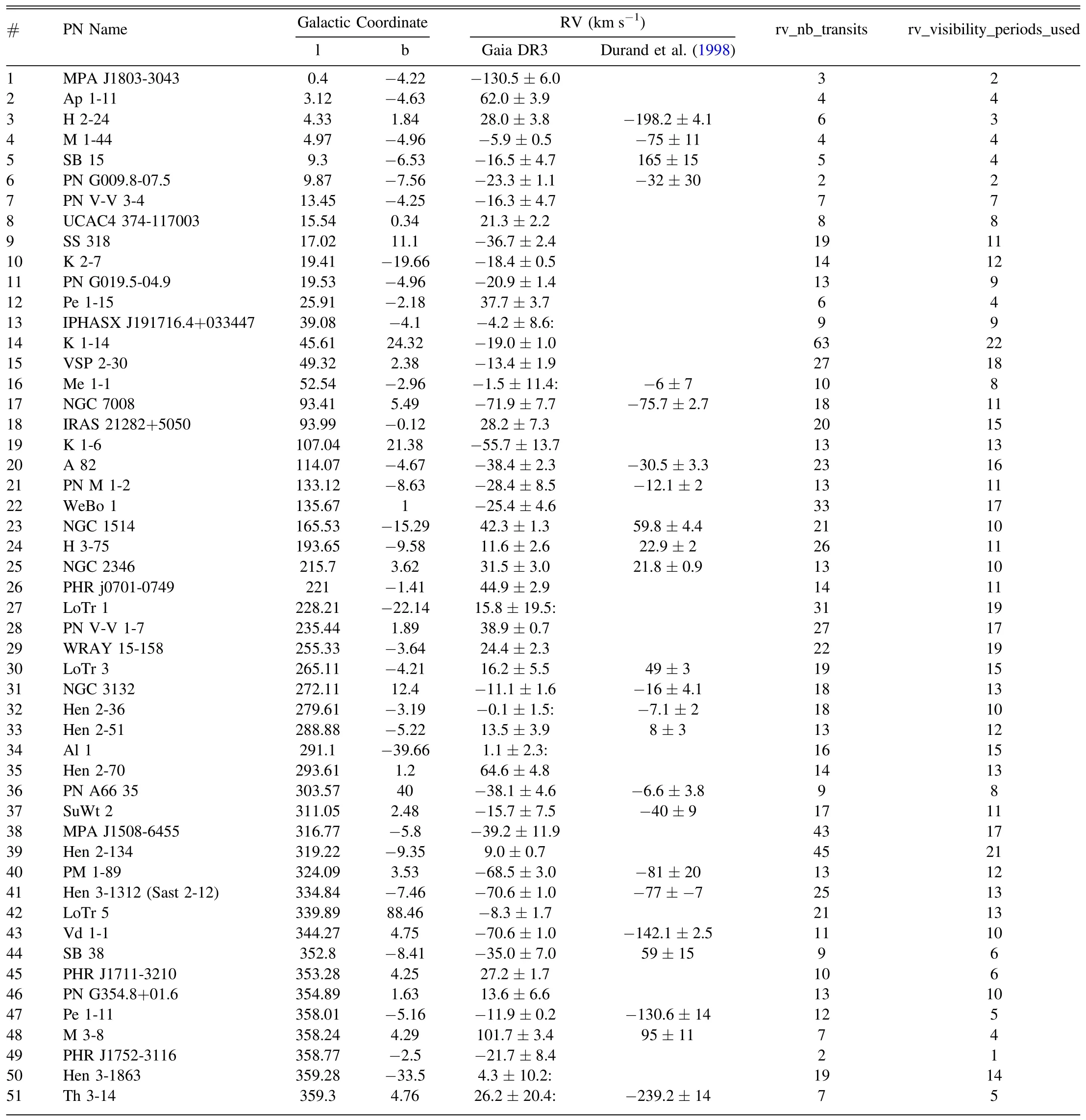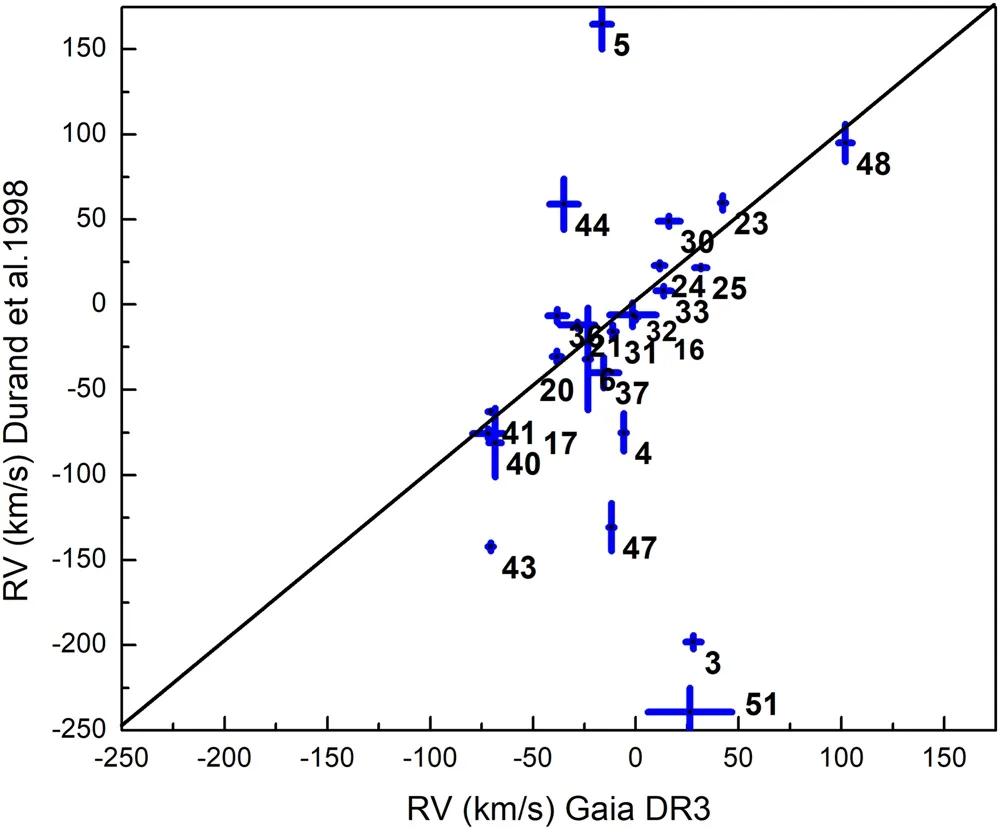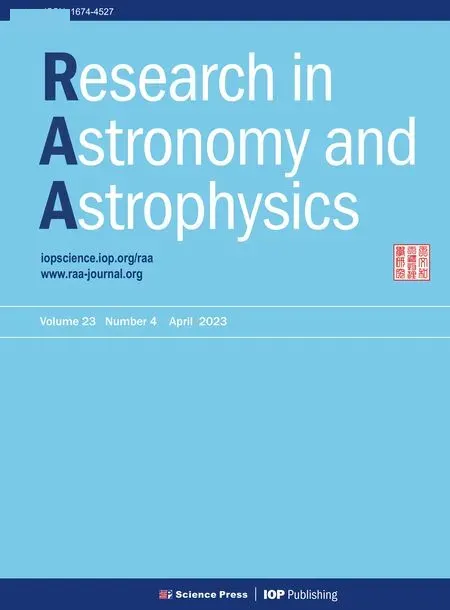The Variability and Radial Velocity of Planetary Nebula Central Stars
A.Ali and A.Mindil
1 Astronomy, Space Science & Meteorology Department, Faculty of Science, Cairo University, Giza 12613, Egypt; afouad@sci.cu.edu.eg
2 Department of Physics, College of Science, University of Jeddah, Jeddah, Saudi Arabia; amindil@uj.edu.sa
Abstract The extremely accurate estimates of stellar variability and radial velocity in the Gaia Data Release 3 (Gaia DR3)have enabled us to examine the close binarity and radial velocity(RV)of central stars(CSs)of planetary nebulae(PNe).This study is twofold: (1) searching for new close binary CS candidates to better understand how binarity affects the formation and evolution of PNe; and (2) extending the sample size of known RVs of PNe in order to understand their kinematics and the dynamics of the Milky Way.As a target sample,we used all true,possible,and likely PNe available in the literature.Then, we looked for their matched Gaia DR3 sources that provide measurements of variability and RV.As a result, we detected the first large collection of trustworthy photometric variability of 26 symbiotic stars and 82 CSs.In this CS group,there are 24 sources already classified as true close binary CSs in the literature.Hence, we discovered 58 new close binary CS candidates.This close binary (CB)sample represents more than half of what is currently available in the literature.In addition,we identified the radial velocities for 51 PNe.To our knowledge, 24 of these were measured for the first time.The RV measurements predicted by Gaia,based on the Doppler shift of the CS absorption lines,and those derived from nebular emission lines, show satisfactory agreement except for a few extremely high-velocity PNe.
Key words: (ISM:) planetary nebulae: general – stars: variables: general – (stars:) binaries: eclipsing – (stars:)binaries: symbiotic – techniques: radial velocities
1.Introduction
Gaia is an ESA project that aims to create a 3D representation of the Milky Way Galaxy.The Gaia Data Release 1 (Gaia DR1) appeared in 2016 September.This was followed by Gaia Data Release 2(Gaia DR2)in 2018 April and Early Data Release 3 (Gaia EDR3) in 2020 December.The Gaia DR3 was published on 2022 June 13.It provides positions and apparent magnitudes of ~1.8 billion sources, as well as parallaxes, proper motions, and colors of ~1.5 billion objects.In comparison to Gaia DR2, Gaia DR3 exhibits significant improvements in astrometric and photometric accuracy, precision,and homogeneity.In addition to updating earlier releases,Gaia DR3 contains new data, such as astrophysical parameters(Creevey et al.2022), BP/RP spectra (De Angeli et al.2022),and variability classification (Eyer et al.2022).According to Eyer et al.(2022),Gaia DR1 has ~3000 variable sources,Gaia DR2 has ~550,000 variable sources,and Gaia DR3 has ~10.5 million variable sources.
The topic of binarity has important implications for our understanding of cataclysmic variables and novae, type Ia supernovae,symbiotic stars(SySts),and other phenomena such as the production of astrophysical jets (Boffin & Jones 2019).Binary interactions occur between stars of all sizes and orbital separations,ranging from compact white dwarfs with 5-minute orbital periods to giant stars with hundred-year orbital periods.From an observational and theoretical perspective,all stars with masses ranging from 1 to 8 solar masses, roughly 95% of the Galaxy’s stellar population, will undergo the planetary nebula(PN)stage of evolution.As a consequence,studying the binary CSs of PNe is crucial to our understanding of many astrophysical phenomena that have traditionally been attributed to single-star evolution (Aller et al.2020).
The Hong Kong/AAO/Strasbourg Hα (HASH) catalog(Parker et al.2016)contains ~3500 PNe,with 80%displaying complex morphologies that differ from sphericity, such as elliptical, bipolar, and multipolar PNe, as well as various internal features such as multi-shells,jets,and knots.Currently,there is widespread agreement on the importance of central star(CS) binarity in understanding PN divergence from sphericity,
where the various morphologies of PNe can no longer be explained by single-star models.Since the number of detected binary CSs has increased significantly over the past decade, it has become obvious that the wide variety of PN morphologies and some of the associated unusual chemical properties are the products of binary evolution.A common-envelope event is the best method for generating an axisymmetric PN via binary interaction.The close binary(CB)fraction is the most rigorous binarity test in PN formation.Despite the challenge of finding CS infrared excesses, De Marco et al.(2013) successfully employed the technique to calculate a binary fraction,obtaining a value of 67%–78%based on I-band excess and 100%–107%based on J-band excess.Douchin et al.(2015)obtained I-band fraction of 40%±20% and J-band fraction of 62%±30%using an improved method and a larger sample.Estimates of the binary fraction range from 20% for photometrically detectable CB to 60%–80% for those identified using the radial velocity(RV)variability and infrared excess approaches.According to Boffin&Jones(2019),the bipolar and multipolar PNe are the result of CB stellar evolution.Wesson et al.(2018)identified a link between the high abundance discrepancy factors(adfs)of PNe and their CS binarity.It was found that all PNe of binary CSs with a period less than 1.15 days had adfs larger than 10 and electron densities of less than 1000 cm-3,whereas those with longer periods had lower adfs and significantly higher electron densities.In addition, they noted that any PN with an extreme adf must contain a CB CS.

Table 1 The Variable CSs in Gaia DR3
In addition to ground-based observations of CB CSs (e.g.,Jones et al.2010; Miszalski et al.2011b, 2009; Hillwig et al.2016), space-based observations, such as those from the Transiting Exoplanet Survey Spacecraft (TESS) (Aller et al.2020)and Kepler satellite(Jacoby et al.2021),have detected a significant number of CB candidates.Most of the photometric variability of these objects can be attributed to the effect of a companion star on the nebular CS.
Gaia DR3 has RVs for ~34 million stars and RV spectrometer spectra for almost a million stars (Katz et al.2022).The Gaia Data Release 4 (Gaia DR4), which will be used to analyze 66 months of data,will extend all RV spectra to a G-magnitude of 16.2 and reveal the RV of ~100 million stars.
In the present article, we aim to uncover the variability and RV of the CSs of PNe using the recent release of the Gaia project.We show the PNe data sample and the approach used for extracting the variability and RV from the Gaia DR3 database in Section 2.Section 3 contains the results and discussion, whereas Section 4 has the conclusions.
2.The Variability and RV Data
The RV spectrometer is a medium-resolution spectrograph (R ≈11,500) covering the wavelength range 846–870 nm (Cropper et al.2018).In total, ~10.5 million objects have been identified as variables in the Gaia DR3.Eyer et al.(2022)reported the presence of 35 types and sub-types of variable objects, where the output of the variability analysis amounts to 17 tables containing a total of 365 parameters.The stellar photometric variability is stored in the gaiadr3.gaia_source table in the field phot_variable_flag.The combined RVs and their formal uncertainties are, respectively, stored in the radial_velocity and radial_velocity_error fields in the gaiadr3.gaia_source table.
To achieve the goals of this article, we searched the Gaia DR3 database for all stars whose positions matched those of PN CSs listed in the HASH catalog as true, possible, and likely PNe.
3.Results and Discussion
3.1.Close Binary of PN Central Stars
Chornay et al.(2021) reported a list of 58 likely CB CSs using the photometric data in Gaia DR2.They detected the variability of these objects not as a direct result of extracting the phot_variable_flag identifier in the gaiadr2.gaia_source module, but according to a method that depends on the flux,magnitude, and color uncertainties of the object (for more details, see Chornay et al.(2021)).
Using the database sample, which is composed of roughly 3500 PNe, we found 113 CSs showing photometric variability through the phot_variable_flag identifier in the gaiadr3.gaia_source table.Looking for more information on each PN in the SIMBAD database and the HASH catalog, we noticed that 27 PNe have been re-classified as SySts and four as M type, hot subdwarf, Mira variable, and Wolf-Rayet stars (see Table 2).The remaining 82 CSs are associated with 75 true, 4 likely,and 3 possible PNe(Table 1).From this list,there are 24 CSs that have been documented as possessing CB systems in the literature.As a result, we have detected 58 new CB CS candidates.This set represents more than half of the known closed binary CSs (Boffin & Jones 2019).
The binarity of a CS may be inferred from its color.The CS is often blue owing to its strong ultraviolet radiation, but there are also a lot of red CSs.This might be explained by the fact that the visible light of the main sequence or red giant companion dominates the CS color.Table 1 shows that approximately 70% of the CSs are red (B-R >0.0), implying that they are possibly CBs.In addition, Table 1 lists the periodicity time and reference for each CS,which is considered a true CB in the literature.Furthermore,we examined the list of variable CSs presented by Chornay et al.(2021), where we found only four stars(listed in Table 1,in boldface style)were explicitly defined as variables using the phot_variable_flag identifier.
The morphological type of each PN that was retrieved from the HASH catalog is given in Table 1.As predicted by most current theories, the majority of suspected CB CSs (85%) are surrounded by bipolar and elliptical nebulae (Boffin &Jones 2019).Moreover, ~50% of these nebulae have multiple shells.In addition, Table 1 contains nine PNe previously identified as having CB CSs and high adfs (Hf 2-2; A66 41;A66 63;K 1-2;Sp 1;HaTr 4,Hen 2-248;NGC 6026;M 3-16).
SySts have the longest orbital periods of all interacting binaries.They consist of an evolved,cool star transferring mass to a much hotter, brighter, compact partner (Iłkiewicz &Mikołajewska 2017).Because the spectra of SySts are similar to those of PNe and H II regions,all the objects in Table 2 werepreviously thought to be PNe.It is worth noting that all SySts in Table 2 are red in color.

Table 2 The Variable SySts in Gaia DR3
3.2.Radial Velocity of PN CSs
The pioneering work for determining the RV of PNe was given by Schneider & Terzian (1983) who published the heliocentric RVs for 524 PNe.The next compilation(867 PNe)was reported by Durand et al.(1998).Beaulieu et al.(1999)reported the RVs of 45 PNe lying in the southern galactic bulge.Based on high dispersion spectra, Richer et al.(2017)reported the RVs of 76 PNe.Numerous other individual RVs are scattered throughout the literature (e.g.,Ali et al.2016;Ali& Dopita 2017, 2019).All the above measurements were derived from the Doppler shift of the nebular spectra.The Gaia mission opened a new window for calculating the RVs from the spectra of observed CSs.The Gaia RV was found by measuring the Doppler shift of a template spectrum and then comparing it to the spectrum that was seen.
Using the current release,we were able to detect the RVs for 51 PNe, including updated values for 14 PNe recorded by Ali et al.(2022).Table 3 lists the newly detected RVs by Gaia DR3 and those obtained by Durand et al.(1998).The estimated median uncertainty of this compilation is 12.2%.In Figure 1,we compared the new RV measurements with those given by Durand et al.(1998).The diagonal line indicates the 1:1 matches.In general, the RVs computed from the spectra of both the CSs (Gaia DR3) and their associated nebulae are in good agreement.However, there are a few outliers related to high-velocity objects, such as H 2-24, SB 15, and Th 3-14.At first glance, all outlier objects have galactic longitudes of 0°–10° or 350°–360°, and galactic latitudes of 0° to±10°,indicating that they are located in the direction of the galactic bulge.To figure out the cause of this discrepancy,we examined the possible physical reasons, such as the interaction between PNe and the interstellar medium (ISM), the effect of nebular electron density, and the accuracy of RV measurements deduced from PNe and CSs.We found that none of these nebulae interact with the ISM, and the available electron density data for these objects did not provide a reasonable explanation.In addition, the accuracy of RV measurementsderived from nebular emission lines is suitable.Thus, we examined the parameters that Gaia used to calculate the RV.We extracted two additional parameters relevant to the Gaia RV calculations:rv_nb_transits(the number of transits used to calculate the RV) and rv_visibility_periods_used (the number of visibility periods used to estimate the RV).Table 3 displays the previous two parameter values in columns 6 and 7.The preceding two parameters show that these outliers have a lower number of transits and shorter visibility periods compared with other RV measurements in Table 3.As a result, we may infer that the difference in RV measurements between the Gaia and nebular lines for these outlier objects is due to Gaia’s inaccurate RV measurements.

Table 3 The CS Radial Velocity of PNe in Gaia DR3

Figure 1.The RVs derived from the Gaia DR3 against those reported by Durand et al.(1998).The diagonal line refers to the 1:1 correlation.The numbers on the plot correspond to the PN numbers that are listed in Table 3.
4.Conclusions
We have discovered 82 PNe associated with CB CS candidates.To our knowledge, 58 members of this group have been found for the first time.This group of CB CSs comprises roughly half of all objects known in the literature.We also discovered photometric variability in 26 SySts and four stars of different types.Moreover,we detected the RVs of 51 PNe,27 of which were identified for the first time.With a few exceptions,there is good agreement between the RVs measured from the absorption lines of the CSs and those measured from the emission lines of the PNe.In future work,we plan to extract the available photometric variability identifiers from the Gaia DR3 database to build the light curves for some of the objects mentioned in Table 1.We also plan to use the 74 inch telescope at the Kottamia Astronomical Observatory, Egypt, to perform a time-series photometric study for a few of the detected CB CS candidates.Simultaneously,we will search the TESS and Kepler sky surveys, as well as the Optical Gravitational Lensing Experiment (OGLE) variable star catalog, for data that will allow us to confirm the binarity of the newly detected objects.
Acknowledgments
The authors would like to thank the reviewer for his or her constructive suggestions that helped enhance the original manuscript.This work has made use of data from the European Space Agency (ESA) mission Gaia (https://www.cosmos.esa.int/gaia), processed by the Gaia Data Processing and Analysis Consortium (DPAC, https://www.cosmos.esa.int/web/gaia/dpac/consortium).Funding for the DPAC has been provided by national institutions, in particular the institutions participating in the Gaia Multilateral Agreement.
ORCID iDs
A.Ali https://orcid.org/0000-0003-4180-8420
 Research in Astronomy and Astrophysics2023年4期
Research in Astronomy and Astrophysics2023年4期
- Research in Astronomy and Astrophysics的其它文章
- 3D Kinematics of Classical Cepheids According to GaiaEDR3 Catalog
- Photometric Monitoring of Blazar 3C 66A with the Yunnan University Astronomical Observatory 1m Telescope
- Influence of Solar Activity on Precise Orbit Prediction of LEO Satellites
- Constraining the Temperature-density Relation of the Inter-galactic Medium from Analytically Modeling Lyα Forest Absorbers
- Collaborative Simulation of Mechanical Structure and Control Systems of Leighton Chajnantor Telescope
- Period Investigation on Two W UMa Binaries HH UMa and V1175 Her
